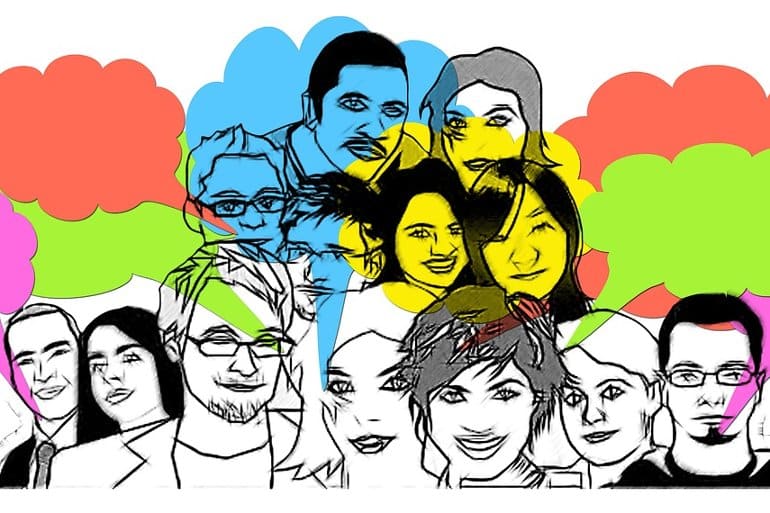Summary: Hearing personal narratives instead of simply cold, hard facts motivates people to change their behaviors to help protect more vulnerable groups.
Source: University of Pennsylvania
The mission of the Annenberg School’s Communication Neuroscience Lab has long been to figure out what kind of messages best push us to engage in healthier habits. As COVID-19 began its sweeping disruption of daily life in March 2020 and behaviors like masking, hand washing, and social distancing became life or death for many, members of the lab immediately felt called to action.
Doctoral candidate Mary E. Andrews was particularly concerned with issues of equity. How can we make clear that slowing the spread of the virus impacts not only our own health and safety, but also helps higher-risk groups who are less able to protect themselves because of their life circumstances? What kind of messaging would best achieve that goal?
In a new study published in Social Science & Medicine, Andrews and her co-authors found that the use of personal narratives, as opposed to strictly fact-based messages, increased people’s beliefs about protecting vulnerable groups, as well as their intentions to engage in helpful actions to benefit others.
The study focused on two groups: healthcare workers and individuals who are incarcerated. The researchers purposely chose groups that experienced severe health inequities during the pandemic but were at opposite ends of the spectrum in terms of perceived social status.
Although neither group got the help it needed during those early days of the COVID-19 outbreak, healthcare workers were heralded as heroes at the front lines of the pandemic, sacrificing their safety amid equipment shortages and other challenges.
Individuals who were incarcerated also faced circumstances beyond their control, with the virus spreading rapidly through prisons and other facilities where physical distancing was difficult or impossible, and basic hygiene provisions were often unavailable.
But, as Andrews points out, the general public often forgets about people who are incarcerated or worse, thinks they don’t deserve help.
“A lot of the research focus has been on people with higher biological risk, such as those who are older or have underlying conditions—and it is really important to help protect those groups,” she says.
“But I wanted to also highlight that some groups are more at risk because of where they live or work or other conditions that have nothing to do with biology, and that they’re still experiencing health disparities.”
If an intervention increased support for these groups, Andrews reasoned, they might work for many others as well.
To test the effectiveness of different messaging, the team had participants read first-person narrative messages told from the perspective of either a healthcare worker or incarcerated person, describing the conditions they were in, how they were impacted, and how they were at higher risk for COVID-19.
These were adapted from real accounts that Andrews pulled from social media posts or news articles and written in a story-like manner with a clear main character and first-person voice. The non-narrative, expository messages included the same basic information, but were told in a more fact-based way with no central character.
Participants either saw messages about individuals who were incarcerated or healthcare workers, and were further randomized to see either the narrative or non-narrative version. A third control group didn’t see any messages.
After each message, participants rated how transported they felt into the story, then answered questions regarding their beliefs about vulnerable groups and intentions to engage in prosocial behaviors.
The researchers found that participants were much more immersed in the narrative messages, where they felt a stronger relatable connection than in the fact-based messages.
Moreover, those who felt more transported were more likely to believe that the group they read about was more vulnerable to COVID-19, and more likely to believe that their own behaviors—staying home when feeling sick, engaging in physical distancing—could impact and protect these groups.
These participants were also more likely to say they would donate to charities that could help the group they read about, or engage in behaviors to help other vulnerable groups.
There is a long research history across a number of fields finding that narrative stories are powerful in shaping beliefs, says senior author Emily Falk, director of the Communication Neuroscience Research Lab and Professor of Communication, Psychology, Marketing, and Operations, Information and Decisions at Penn.
“Mary’s work is important,” Falk says, “because it shows causally that when we only change this one ingredient—tweaking a text to highlight a person’s personal story versus just framing it as facts—it helps people feel transported into the information about COVID-19.”
As Falk further explains, these findings have significant real-world implications when it comes to planning public health interventions, as they demonstrate how messaging can shift an individual’s perspective and might promote behavioral changes.

“Using narratives, we can help people understand why it’s important to protect everybody in society in this moment, and they can help us humanize other people in valuable ways,” Falk says.
As researchers continue learning more about both the short- and longer-term effects of the pandemic on people’s well-being, health, and safety, Andrews emphasizes that sharing first-hand stories from members of different communities can help create guidelines to best help vulnerable groups, shift societal attitudes around them, and call more attention to their needs.
“Maybe for a lot of us, we can go back to some version of regular day-to-day life. But if we share stories from groups like those who are incarcerated, showing that they are still deeply into this pandemic and don’t have the same kind of freedom as we have now, more can be done to help them,” she says.
“As this study shows, having real stories from people and groups that are more marginalized, or even just reading stories from people who are not like you, can make you more likely to want to engage in behaviors that help others.”
About this psychology and motivation research news
Author: Michele Berger
Source: University of Pennsylvania
Contact: Michele Berger – University of Pennsylvania
Image: The image is in the public domain
Original Research: Closed access.
“Using first-person narratives about healthcare workers and people who are incarcerated to motivate helping behaviors during the COVID-19 pandemic” by Mary E. Andrews et al. Social Science & Medicine
Abstract
Using first-person narratives about healthcare workers and people who are incarcerated to motivate helping behaviors during the COVID-19 pandemic
Rational
Overcoming the COVID-19 pandemic requires large-scale cooperation and behavior change on an unprecedented scale. Individuals can help reduce the burden of the pandemic by participating in behaviors that benefit people whose life circumstances make them especially vulnerable.
Objective
We tested the effect of reading narrative (i.e., story-like) as opposed to expository (i.e., factual recounting) messages on beliefs about protecting others in groups vulnerable during the pandemic through increased message transportation (i.e. immersing the reader into the story). Additionally, we examined if reading narratives, as opposed to expository messages, increased intentions to engage in prosocial behaviors that benefit these groups through increased transportation.
Methods
The study used a between-subjects design where participants either read narrative or expository messages about the experiences of people who were at greater exposure to SARS-CoV-2 due to social and political factors, namely people who were incarcerated or working in healthcare during the onset of the COVID-19 pandemic.
Results
In line with pre-registered hypotheses, participants in the narrative (vs. expository) condition reported greater transportation into the message. We also observed indirect effects of narrative (vs. expository) messages, through increased message transportation, on: (1) beliefs that by physical distancing, one can protect vulnerable people (2) beliefs that members of the target groups (i.e., healthcare workers and people who are incarcerated), were vulnerable during the pandemic, (3) intentions to engage in prosocial behaviors that help family and friends, and (4) intentions to engage in prosocial behaviors that help members of vulnerable groups.
Conclusion
Together these results suggest that narratives can be used to motivate prosocial action during the COVID-19 pandemic to the extent that the narratives elicit transportation.






